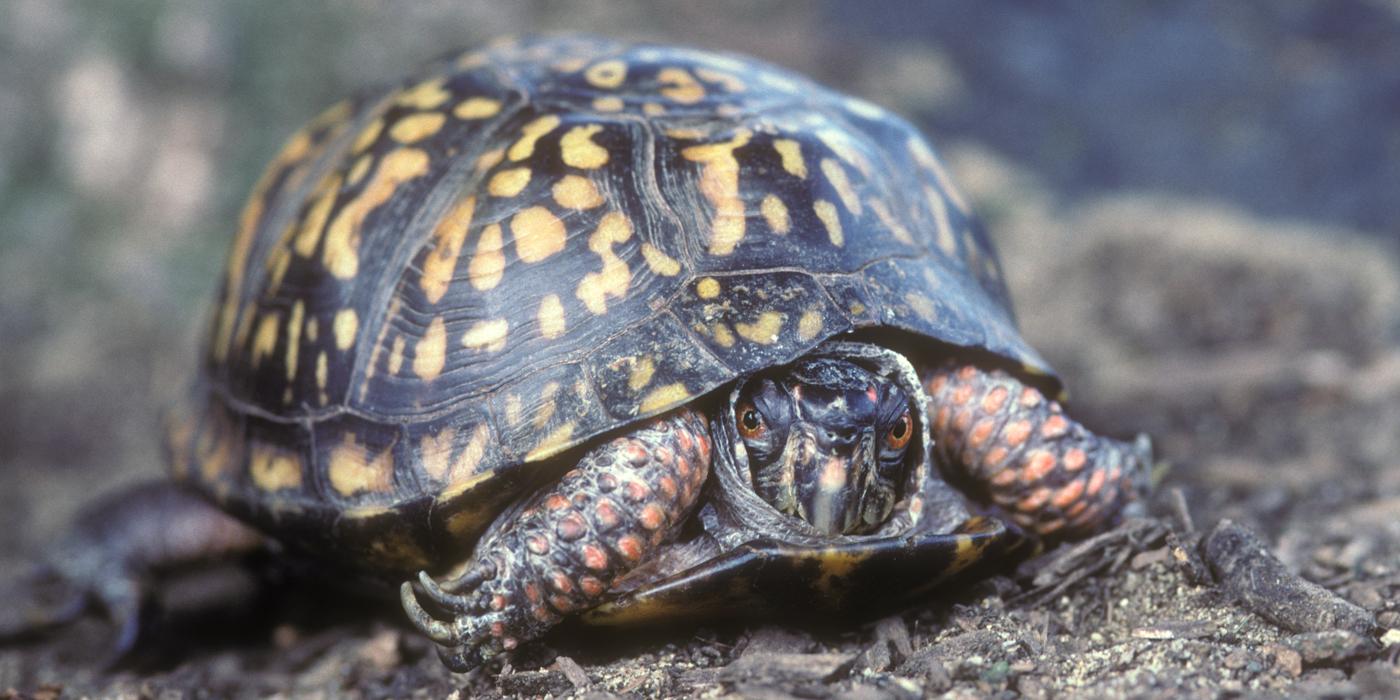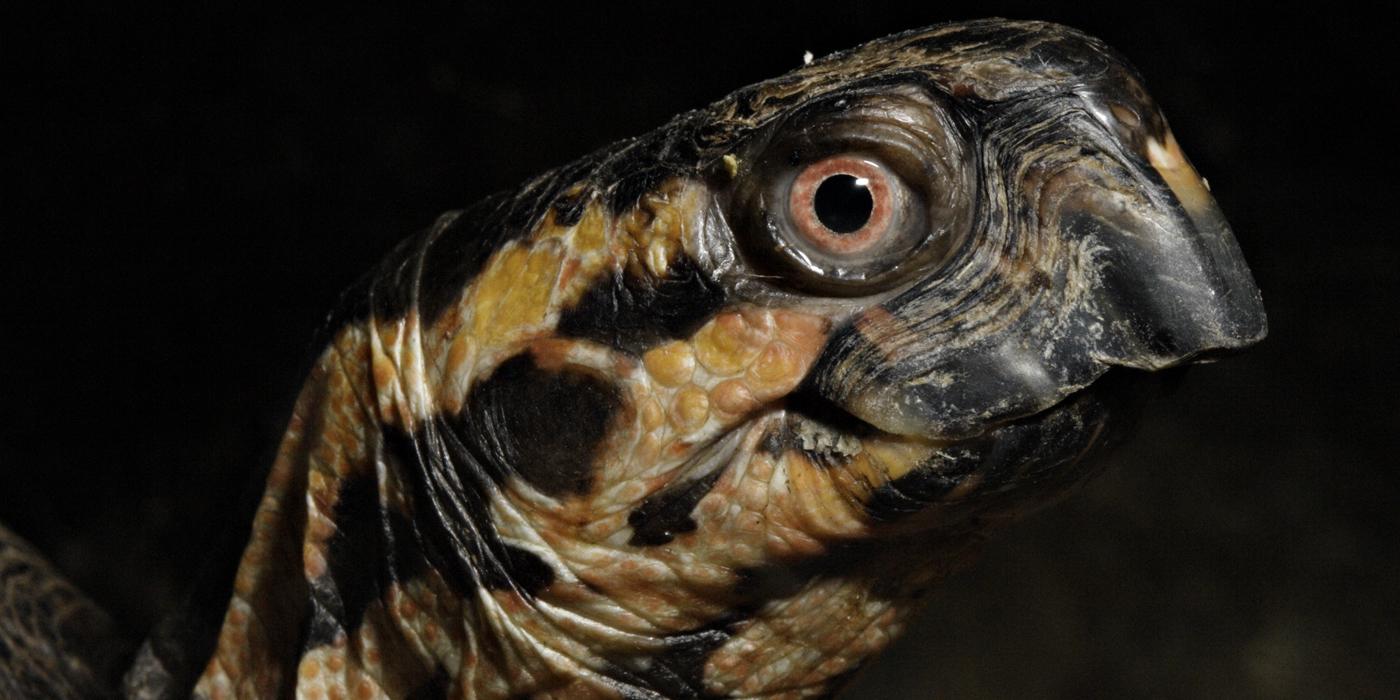The eastern box turtle, a subspecies of the common box turtle, has a dark brown, hinged shell with yellow-orange markings. When threatened, it can pull its head, tail and limbs inside and shut its shell for protection.
Physical Description
The eastern box turtle is one of six extant subspecies of the common box turtle. It has a high-domed, rounded, hard upper shell, called a carapace. The vivid, orange and yellow markings on its dark brown shell distinguish it from other box turtles, as do the four toes on its hind feet. Its distinct coloring camouflages it among the damp earth, fallen leaves and other debris found on the floor of moderately moist forests.
The underside of its shell, called its plastron, is dark brown and hinged. All box turtles have this bilobed plastron, which allows them to almost completely shut their shell. When threatened, the box turtle pulls its body into its shell and waits for the danger to pass. Its shell is also unique in that it can regenerate. In one reported case, the carapace of a badly burned box turtle completely regenerated.
Box turtles have a hooked upper jaw, and most have a significant overbite. Their feet are slightly webbed. There are many ways to tell a male and female box turtle apart. Males are generally larger and have shorter, thicker tails than females. Males also have short, thick, curved hind claws, while females' hind claws are long, straight and thin.
Eastern box turtles walk energetically with their heads upright and may travel about 50 meters (55 yards) in one day. A homing instinct, an innate ability to navigate to a "home base" despite being in an unfamiliar area, helps this turtle find its way back home.
Size
Eastern box turtles typically grow to 10 centimeters by 15 centimeters (4 inches by 6 inches). They are a bit larger than other subspecies within their range. The largest box turtle is the Gulf Coast box turtle, which is found along the northern region of the Gulf of Mexico.
Native Habitat
The eastern box turtle is one of the few native species housed at Reptile Discovery Center. Box turtles of all subspecies are found throughout North America, the eastern Gulf coast of Mexico, and the Yucatan Peninsula. The subspecies Terrapene c. carolina, commonly referred to as the eastern box turtle, is found along the eastern United States from Maine to Florida, and west to the Great Lakes region and Texas.
Eastern box turtles are predominantly terrestrial and live in a variety of vegetative areas, including shrubby grasslands, marshy meadows, open woodlands and field forest edges. They are often found near streams or ponds, or areas that have experienced heavy rainfall.
Lifespan
Box turtles generally live for 25-35 years but have been known to survive to over 100 years old!
Food/Eating Habits
These opportunistic omnivores eat a wide variety of plants, mushrooms, fruits, insects, fish, small amphibians, eggs and even animal carrion. Younger box turtles grow very rapidly and tend to be preferentially carnivorous (for the needed energy). Therefore, they spend more time in the water where it is easier to hunt. After five to six years, they move onto the land and shift to a more herbivorous diet.
At the Smithsonian's National Zoo, eastern box turtles eat salad, earthworms, pellets and, on occasion, mealworms.
Sleep Habits
Eastern box turtles adjust their activity in order to maintain their optimal body temperature. In the summer, they are most active early in the morning or after it rains. When it gets too hot, they find cool areas to rest, such as under logs, leave piles, mud or abandoned mammal burrows. During the spring and fall, they are active throughout the day and enjoy lying in the sun to get warm.
Eastern box turtles that live in southern regions remain active throughout the winter. In the northern regions where it gets too cold, they find a comfortable place where they can be somewhat insulated, called a hibernaculum, and will become lethargic, entering a hibernation-like state known as brumation. This begins in October or November and ends in April when they emerge again. Sometimes, during warm winters, they will wake up and find another resting site.
Social Structure
These turtles usually have a home range with a diameter of 230 meters (750 feet) or less in which they normally stay. Home ranges of different individuals overlap frequently regardless of age or sex. Turtles are often found together and show no antagonism toward each other. While aggression between individuals is not common, competing males will spar each other. This involves biting at each other’s shells.
Reproduction and Development
Box turtles reach sexual maturity around the age of 5. Mating season for eastern box turtles generally starts in the spring and continues through the fall. After a rainfall, males become especially active in their search for a female. Males may mate with more than one female or the same female several times. Females can store sperm for up to four years and therefore do not mate every year. In fact, a female could lay fertile eggs up to four years after a successful mating!
Nesting season occurs from May to June. Females generally lay four or five eggs, but it is not uncommon for them to lay anywhere from one to 11. The female uses her hind legs to dig a nest in sandy soil. She then covers the eggs, which incubate and hatch on their own. Box turtles exhibit temperature dependent sex determination; eggs incubated at 22-27 degrees Celsius (70-80 degrees Fahrenheit) are more likely to be males, and those incubated above 28 degrees Celsius (82 degrees Fahrenheit) are more likely to be females.
Conservation Efforts
Habitat destruction has led to a decline of eastern box turtles in their former range. Throughout the past century, the conversion of woodlands and wetlands into agricultural land has extirpated populations where they once existed.
The rising demand for the development of suburban areas further exacerbates the decline by fragmenting the populations that are left. Because they are so energetic on land, these animals are often killed by vehicles traveling on roads that cross through their remaining habitats.
Eastern box turtles are also a popular commodity in the international market as exotic pets, and a listing by CITES now regulates the commercial trade of this species. While box turtles are no longer caught in large numbers for the pet industry, individuals are still caught as personal pets, as well as for turtle racing. Pet turtles that are later released may pose threats to the native populations by introducing disease.
Box turtles benefit greatly from protected areas, which maintain natural habitats and protect them from the dangers of high traffic. Many states also have laws that protect wild box turtles from capture. Additional measures, such as creating wildlife crossings, translocation or developing replacement habitat, could help further protect box turtles.
Help this Species
- Reduce, reuse and recycle — in that order! Cut back on single-use goods, and find creative ways to reuse products at the end of their life cycle. Choose recycling over trash when possible.
- Organize or attend a stream, river, lake or other waterway cleanup in your area to preserve aquatic habitats for local species.
- Share the story of this animal with others. Simply raising awareness about this species can contribute to its overall protection.





